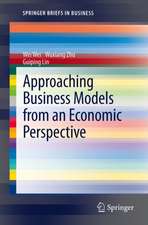The Principle of Profit Models
Autor Guiping Lin, Wei Wei, Wuxiang Zhuen Limba Engleză Hardback – 27 ian 2015
Preț: 389.88 lei
Nou
Puncte Express: 585
Preț estimativ în valută:
74.61€ • 79.78$ • 62.20£
74.61€ • 79.78$ • 62.20£
Carte tipărită la comandă
Livrare economică 17 aprilie-01 mai
Preluare comenzi: 021 569.72.76
Specificații
ISBN-13: 9783662447130
ISBN-10: 3662447134
Pagini: 200
Ilustrații: XIV, 184 p.
Dimensiuni: 155 x 235 x 15 mm
Greutate: 0.46 kg
Ediția:2015
Editura: Springer Berlin, Heidelberg
Colecția Springer
Locul publicării:Berlin, Heidelberg, Germany
ISBN-10: 3662447134
Pagini: 200
Ilustrații: XIV, 184 p.
Dimensiuni: 155 x 235 x 15 mm
Greutate: 0.46 kg
Ediția:2015
Editura: Springer Berlin, Heidelberg
Colecția Springer
Locul publicării:Berlin, Heidelberg, Germany
Public țintă
ResearchCuprins
Profit sources (Stakeholders). -Fixed income.- Remaining profit.- Profit sharing.- Customer pricing.- Auction.- Combined pricing.
Notă biografică
Guiping LIN, Ph.d, HSBC Business School, Peking University, University Town, Nanshan District, 518055, Shenzhen, China, People's Republic.
Wei WEI, Associate Professor, HSBC Business School, Peking University, University Town, Nanshan District, 518055, Shenzhen, China, People's Republic.
Wuxiang ZHU, Professor, Finance Department, School of Economics, Tsinghua University, Beijing, China, People's Republic.
Wei WEI, Associate Professor, HSBC Business School, Peking University, University Town, Nanshan District, 518055, Shenzhen, China, People's Republic.
Wuxiang ZHU, Professor, Finance Department, School of Economics, Tsinghua University, Beijing, China, People's Republic.
Textul de pe ultima copertă
This book mainly focuses on defining profit models, on how many main kinds of profit models there are, how profit models can change a company, and how to tailor a profit model to the needs of a certain company. In this context, profit models are classified as fixed-income, remaining-profit and profit-sharing, admission, toll, parking, fuel and sharing fees, profit sources, customer pricing, auction, combined pricing, etc. The logic behind all these profit models will be analyzed in detail and numerous micro-cases will be introduced. All of the micro-cases discussed are the best profit model practices used by outstanding enterprises, mainly from China and the USA (including HomeAway, Priceline, Tencent, Sina, Google, the Voice of China, CSPN and so on). These models will be complemented by a wealth of figures and additional tools to help readers better understand the principle of profit models. As such, the book not only explains “why” entrepreneurs preferred to apply a specific kind of profit model and not others, but also answers “how” they derived that model.
Caracteristici
Combines academic with practitioner's perspective Introduces best profit models practices of the most outstanding enterprises mainly from China and USA Answers “why” entrepreneurs applied this kind of profit model other than others, and “how” they came out with the profit model as well Includes supplementary material: sn.pub/extras




















